The argument for using scientific names (against using common names alone) in sourcing and discussing plants.
Read moreScientific names rule. Here's why
common names suck.png
Your Custom Text Here

common names suck.png
The argument for using scientific names (against using common names alone) in sourcing and discussing plants.
Read moreI have come to loathe the term "low maintenance". It is essentially meaningless. I am starting to wonder if when a client requests a "low maintenance" design, what they're really saying is that they don't want to do any work themselves, including taking the trouble to find a decent gardener or asking questions.It is imperative for both the client and the designer to discuss exactly what types of gardening activities may occur before doing any design work. Be honest! REALLY! For example, when I got my hair cut last week, I told the stylist that I wash and comb my hair, nothing more. I would not promise to use any appliances or products, and she gave me a cut that works well for my specific needs. You can see from the above photo (taken on my patio earlier this month) that thanks to my personal distaste for weeding, I have a number of (un-planned) plants just growing together, willy-nilly, doing their thing. I am okay with that, so this is the design solution that my personal garden employs. I'll let nearly anything grow as long as it is healthy and doesn't produce anything painful (thorns, burrs, stingers). This works for me because I live in an apartment and I know that if/when I move, the whole thing will be ripped up - there's not much to be gained by fretting over weeds. Given a different situation, my personal garden might look quite different or it might not.I also grow several roses and a few shrubs - some in containers, some not. I grow dozens of rare bulbs, more than dozens of perennials, and a few orchids, but I don't do much "work". Every year I reliably cut Roses, Freesias, and Sweet Peas for indoor bouquets. I know that rose flowers develop at the very end of a branch and that each cut to remove a flower is, in fact, a pruning cut (and where to take that cut). I also know that my Sweet Peas will bloom nearly forever as long as I keep cutting the flowers off - it is just terrible having an apartment full of sweet pea flowers, just awful...
You can see from the above photo (taken on my patio earlier this month) that thanks to my personal distaste for weeding, I have a number of (un-planned) plants just growing together, willy-nilly, doing their thing. I am okay with that, so this is the design solution that my personal garden employs. I'll let nearly anything grow as long as it is healthy and doesn't produce anything painful (thorns, burrs, stingers). This works for me because I live in an apartment and I know that if/when I move, the whole thing will be ripped up - there's not much to be gained by fretting over weeds. Given a different situation, my personal garden might look quite different or it might not.I also grow several roses and a few shrubs - some in containers, some not. I grow dozens of rare bulbs, more than dozens of perennials, and a few orchids, but I don't do much "work". Every year I reliably cut Roses, Freesias, and Sweet Peas for indoor bouquets. I know that rose flowers develop at the very end of a branch and that each cut to remove a flower is, in fact, a pruning cut (and where to take that cut). I also know that my Sweet Peas will bloom nearly forever as long as I keep cutting the flowers off - it is just terrible having an apartment full of sweet pea flowers, just awful...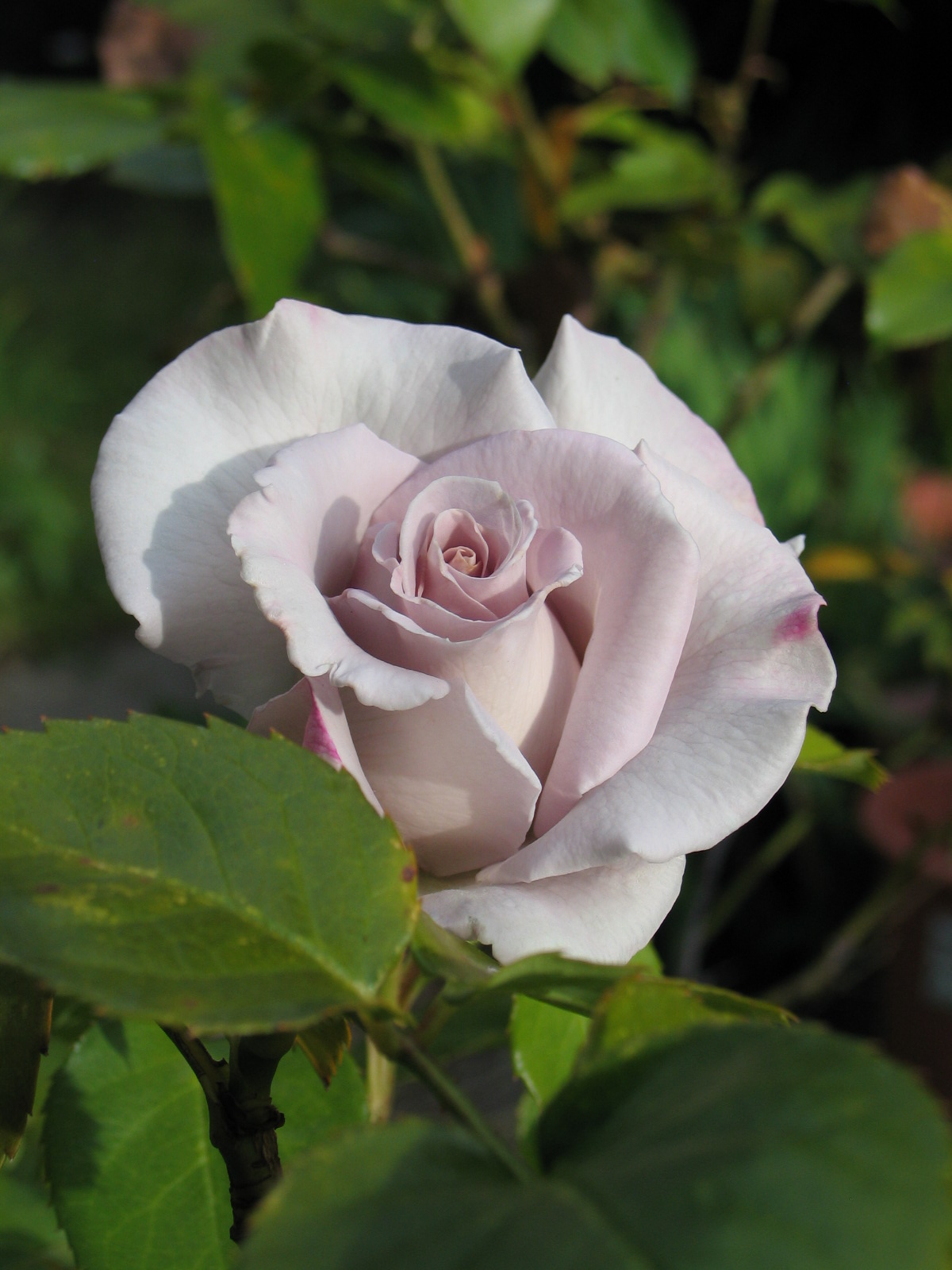 There are countless ways to design a garden so that it doesn't feel like a ton of unwanted work, and so that taking care of it is at least somewhat enjoyable. Getting it to that point is as good a reason as any to work with a design professional and/or do a bit of research for your own garden design solutions....but please don't call cutting flowers "maintenance", that just takes out all the fun.
There are countless ways to design a garden so that it doesn't feel like a ton of unwanted work, and so that taking care of it is at least somewhat enjoyable. Getting it to that point is as good a reason as any to work with a design professional and/or do a bit of research for your own garden design solutions....but please don't call cutting flowers "maintenance", that just takes out all the fun.
I am working on the design of a garden in San Francisco and was pleasantly surprised today by the delivery of the Hellebores that were ordered from Canada. While I was potting them for protection during their wait to be installed at the site, it occurred to me that this shipment of plants represented some thoughts on customer service and the design/construction processes.Most Landscape Architecture firms would not be able to accept delivery of plants for a client and care for those plants until they could be installed. They might rely instead on either using only the plants that are seasonally available or contract growing (with someone else) to care for those plants that must be received before the site is ready. There are issues of liability (what if they die?!), space, and materials for the task. What results can be either a prohibitively complicated and expensive ordeal, a garden that is skewed to one particular season, or having to ask the client to be patient and wait while plants become available in the future (not always acceptable by some clients). 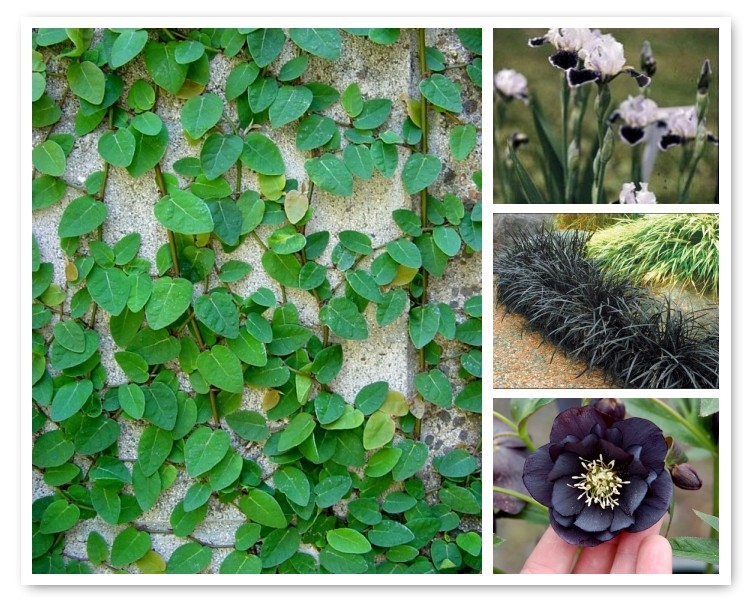 Included in this particular project there will be a discrete courtyard featuring a statue. We are using four different plants; Ficus pumila (Creeping Fig), Ophiopogon nigrescens (Black Mondograss), Helleborous 'Onyx Odyssea' (a double black flowering Lenten Rose), and Iris 'Frosted Velvet' (a "miniature tall" form Bearded Iris). The Ficus and Ophiopogon are evergreen and will form the main planting to show off the sculpture, then the Iris will be in bloom in the Spring with leaves from late Winter through Summer, and the Hellebores will be in bloom in Winter with leaves holding on through Spring. I don't expect to have both Irises and Hellebores flower at the same time, though it is possible that this could occur depending on weather conditions and temperatures (especially in the Bay Area). While the Irises prefer more sun and the Hellebores more shade, the site location and orientation make it possible to use both in the same small area.I presented the palette (above) to the client earlier this month. Before doing presenting, I learned that the Iris were not going to be shipped until next July, and that our local growers who carried the Hellebores had already sold out for the year. I explained to the client that we would be ordering the Iris for delivery nine months in the future and that the Hellebores would need to be ordered immediately from Canada before the grower's shipping season closed. He accepted the planting concept, so I had the plants ordered with delivery to my home. I did this for a couple of reasons:1. I wanted to inspect the plants before anyone else saw them to make sure there were no problems (and I work from home). Having them shipped to my home also meant that I could accept delivery at any time (they arrived today - the Saturday after Thanksgiving) regardless of holidays, weekends, and business hours.2. The plants would be shipped bare root and would need immediate attention by someone who knew what to do and had the time.3. The landscape contractor had not yet been formally retained.4. This also made me feel that I was giving my client the best service I could by personally protecting his investment in them and, by extension, his trust in me.It is my habit to order plants from all over the world. Because of this, I knew ahead of time that both mail order companies were reputable and that the plants would likely be in great shape. I was not disappointed! Fraser's Thimble Farms worked with me to hold the plants until the payment arrived. I took their advice to pay for air priority shipping. The plants also required a Phytosanitary Certificate (they were inspected by the Canadian Food Inspection Agency) before coming into the U.S. The shipment was also opened and inspected by U.S. Customs upon arrival.Below are some photos from this morning's potting:
Included in this particular project there will be a discrete courtyard featuring a statue. We are using four different plants; Ficus pumila (Creeping Fig), Ophiopogon nigrescens (Black Mondograss), Helleborous 'Onyx Odyssea' (a double black flowering Lenten Rose), and Iris 'Frosted Velvet' (a "miniature tall" form Bearded Iris). The Ficus and Ophiopogon are evergreen and will form the main planting to show off the sculpture, then the Iris will be in bloom in the Spring with leaves from late Winter through Summer, and the Hellebores will be in bloom in Winter with leaves holding on through Spring. I don't expect to have both Irises and Hellebores flower at the same time, though it is possible that this could occur depending on weather conditions and temperatures (especially in the Bay Area). While the Irises prefer more sun and the Hellebores more shade, the site location and orientation make it possible to use both in the same small area.I presented the palette (above) to the client earlier this month. Before doing presenting, I learned that the Iris were not going to be shipped until next July, and that our local growers who carried the Hellebores had already sold out for the year. I explained to the client that we would be ordering the Iris for delivery nine months in the future and that the Hellebores would need to be ordered immediately from Canada before the grower's shipping season closed. He accepted the planting concept, so I had the plants ordered with delivery to my home. I did this for a couple of reasons:1. I wanted to inspect the plants before anyone else saw them to make sure there were no problems (and I work from home). Having them shipped to my home also meant that I could accept delivery at any time (they arrived today - the Saturday after Thanksgiving) regardless of holidays, weekends, and business hours.2. The plants would be shipped bare root and would need immediate attention by someone who knew what to do and had the time.3. The landscape contractor had not yet been formally retained.4. This also made me feel that I was giving my client the best service I could by personally protecting his investment in them and, by extension, his trust in me.It is my habit to order plants from all over the world. Because of this, I knew ahead of time that both mail order companies were reputable and that the plants would likely be in great shape. I was not disappointed! Fraser's Thimble Farms worked with me to hold the plants until the payment arrived. I took their advice to pay for air priority shipping. The plants also required a Phytosanitary Certificate (they were inspected by the Canadian Food Inspection Agency) before coming into the U.S. The shipment was also opened and inspected by U.S. Customs upon arrival.Below are some photos from this morning's potting: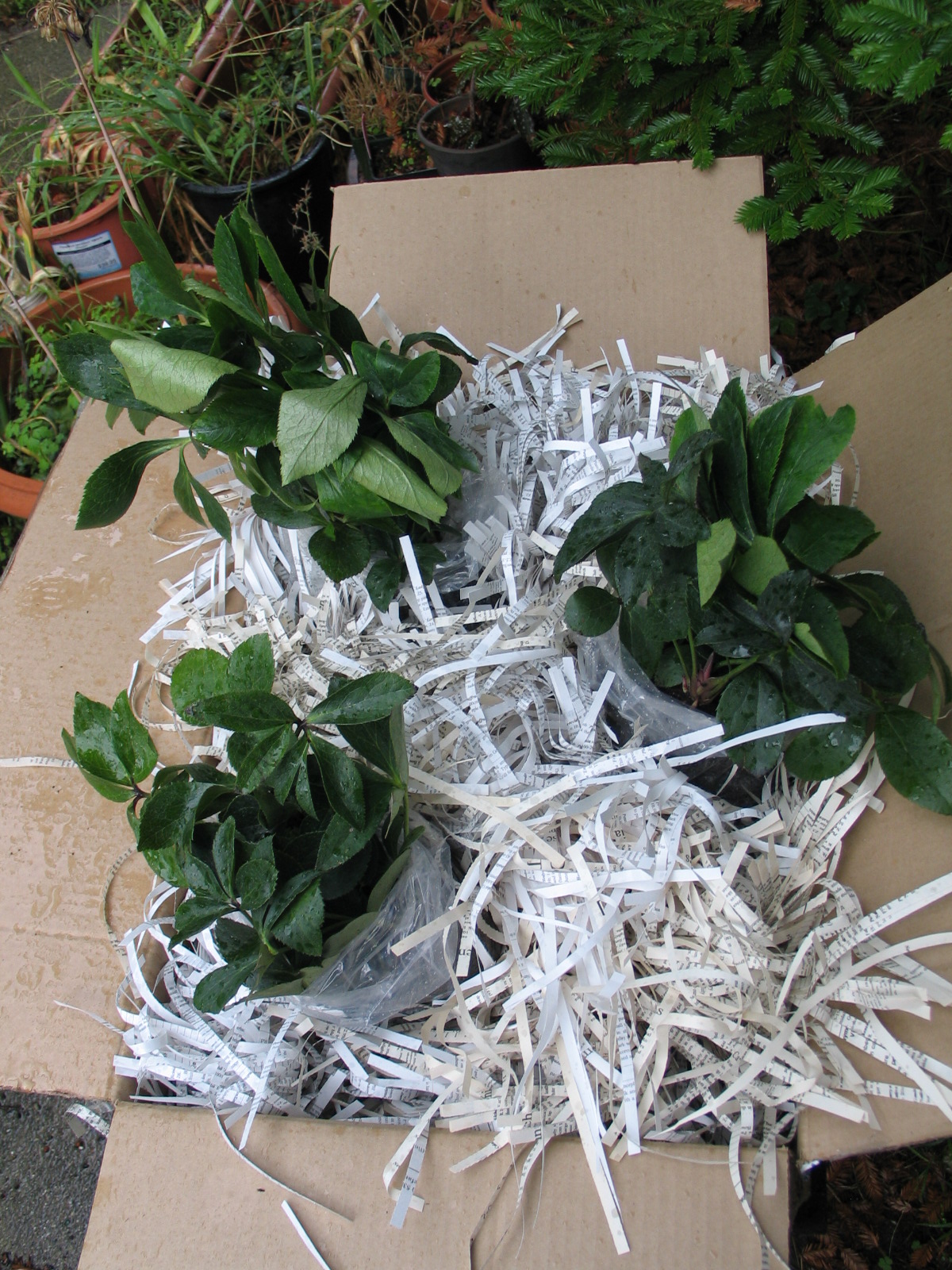

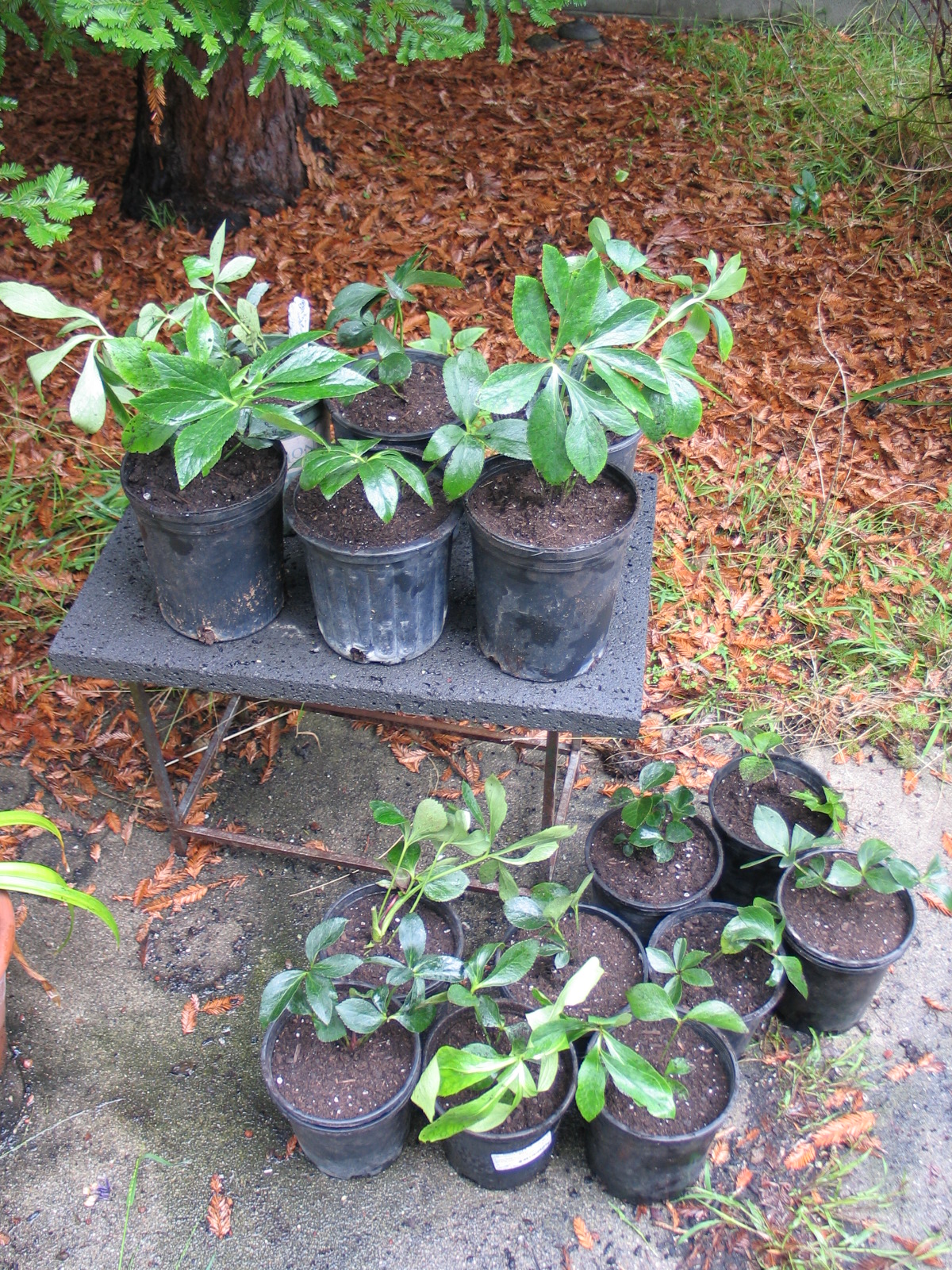 All in all, excellent plants - potted and ready for what comes next. My own Hellebores have not leafed-out yet, so it will be interesting to see how these behave, but they each have new growth on them (see the middle photo). They've been through a lot, being bare-rooted, inspected twice, then finally re-potted (they'll be disturbed again soon when they're planted in their new home).I have been frustrated in the past with the issues that come up when trying to design a garden around the seasonal availability of the plants I want to use. I think it is well worth the extra effort to get the exact plants desired rather than giving up and just finding something else that is less of a pain. I am looking forward to seeing them planted in their new home and will post again....
All in all, excellent plants - potted and ready for what comes next. My own Hellebores have not leafed-out yet, so it will be interesting to see how these behave, but they each have new growth on them (see the middle photo). They've been through a lot, being bare-rooted, inspected twice, then finally re-potted (they'll be disturbed again soon when they're planted in their new home).I have been frustrated in the past with the issues that come up when trying to design a garden around the seasonal availability of the plants I want to use. I think it is well worth the extra effort to get the exact plants desired rather than giving up and just finding something else that is less of a pain. I am looking forward to seeing them planted in their new home and will post again....
It seems that everyone is aware that gardens can require some effort to maintain. Professionals in the landscape design and construction industry understand that the success of any outdoor space depends on thoughtful design, quality installation, and ongoing, intelligent maintenance. Not one of these three items can deliver the desired result without the other two.
Read more"Could I request a post on finding and making first contact with a designer for those of us with gardens out of your jurisdiction so to speak? You’ve convinced me that outside help would be a good idea for my yard, but I don’t know where to go for it, and I don’t want to give the wrong first impression by not knowing the right terms."
Read moreI just got this blog post in my e-mail from Seth Godin this morning which ties in nicely with the book What Your Contractor Can't Tell You that my good friend Susan introduced me to. Nevermind that Mr. Godin uses logo design as his example, and never mind that the book focuses on working with Architects and contractors as opposed to Landscape Architects. BOTH sources discuss the same notion: being a "good" client, or at the very least, an informed one (weirdly, though, they seem to disagree on some points)."Good" clients are beneficial to the entire process, save everyone time, money, and headaches. The responsibility is not the client's alone, however. When the relationship between the client and the professionals they've hired is a productive one, the project always benefits. I am thinking about getting extra copies of that book for my office (knowing full well that suggesting to someone that they read either the post or the book won't necessarily result in them reading either). It is that good. No, really. The $15. you spend on that book can save you thousands in the long and short run. Not a bad return on investment!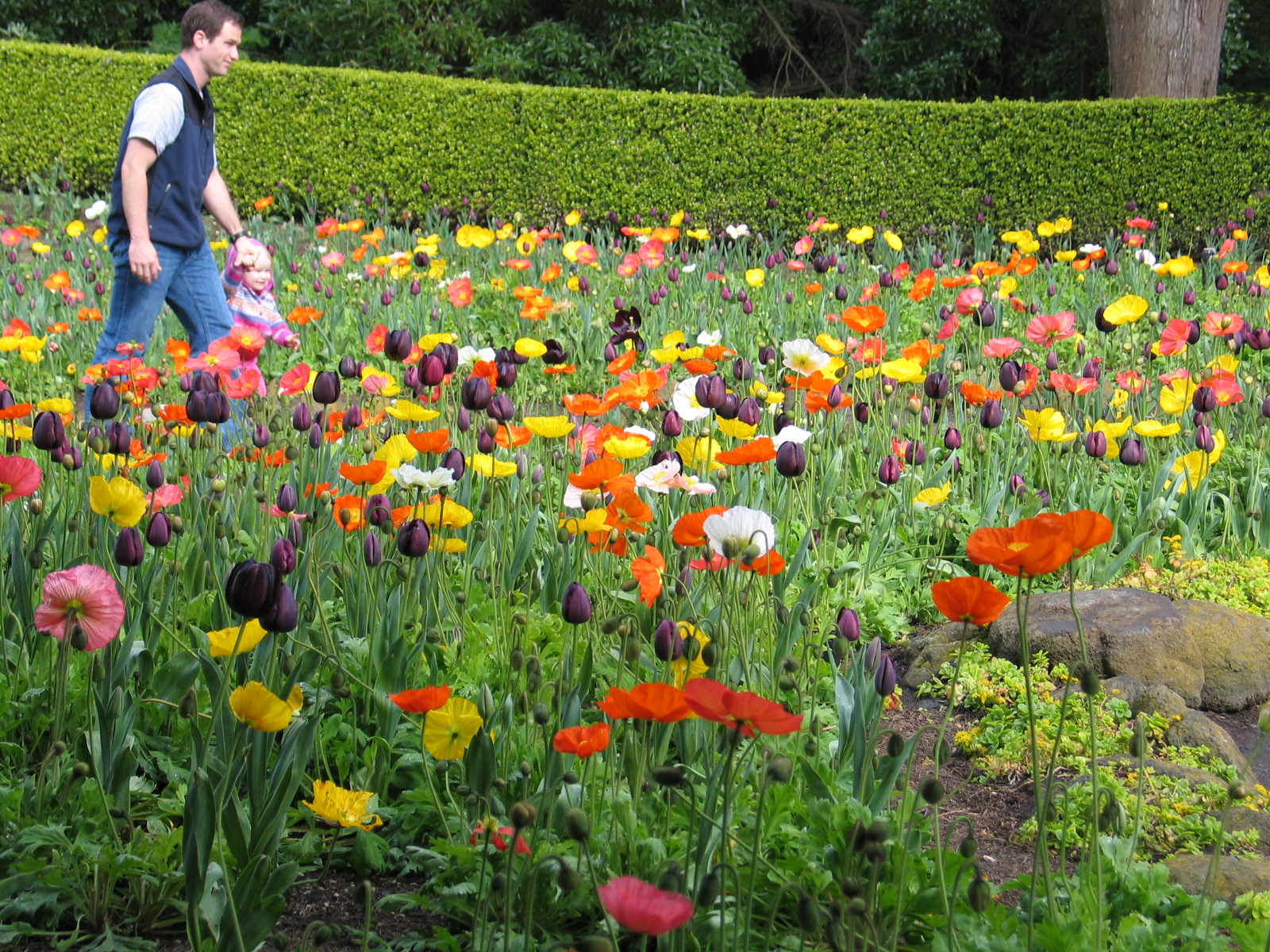 I leave you with images from the Windmill Garden in San Francisco - a seasonal planting that I really enjoyed back in April 2006.
I leave you with images from the Windmill Garden in San Francisco - a seasonal planting that I really enjoyed back in April 2006.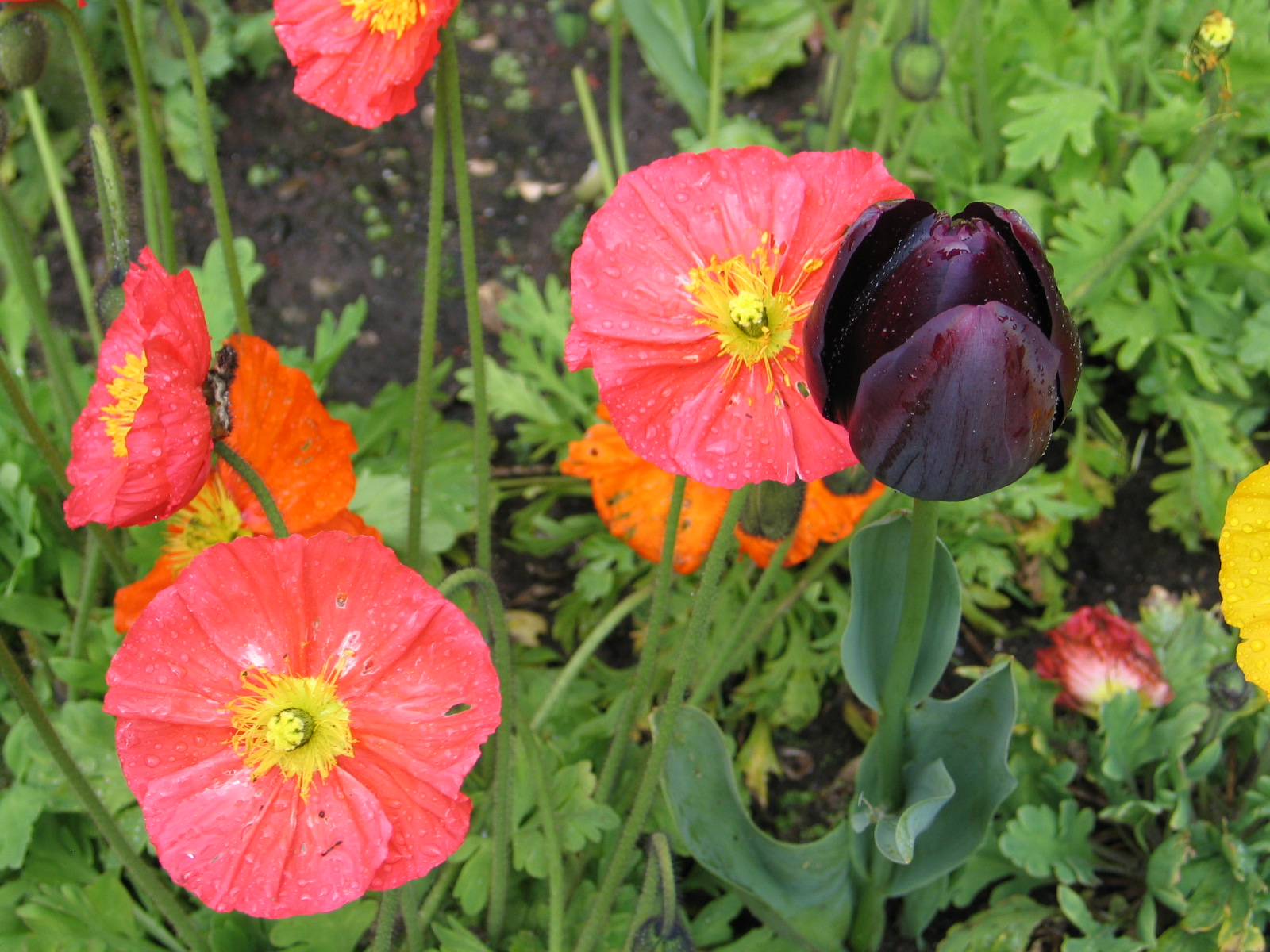

Photo by Aarón Blanco Tejedor on Unsplash
I have decided that I dislike client questionnaires very much. For the purpose of designing a landscape of any sort, they fall far short of useful. I am sure someone somewhere found a client who enjoyed filling out forms, but I have yet to meet any prospective landscape project or client who responded well to (or was well-served by) a written questionnaire.
Read more
Photo by Andy Beales on Unsplash
Pay close attention to the wording under Landscape Contractor, Nurserypersons, and Unlicensed Persons as opposed to the wording for Landscape Architect.
Read more
pagoda lid flowers contest
How long will it take?Every client wants to know the answer to this question, and most want the answer right up front. Some even want to know before the designer has been to the site. Understandable, but unrealistic.In all honesty, it takes as long as it takes. One factor is coordinating the clients', designer's, and contractor's schedules. Everyone is busy, that is a part of life. There is sometimes a lot of time wasted waiting for meetings - simple math.Deciding: Some clients need more time to ponder decisions than others. It can take a while to get responses to calls made to a variety of consultants, municipalities, etc - research of any kind requires a bit of patience. Never mind the time required for neighbor comment periods in some areas (eeek)! There is also the design work itself and the time it takes to produce the documents needed for each meeting.Scope! Not the mouthwash. If the list of things that the designer and the client are working on together is extensive, that can take some time. It is funny sometimes, how designing for a residence can be as time consuming as for a public park. Projects on such an intimate scale, especially because they are where someone lives, can hold a great deal of meaning and detailing. Details all the way down to the angle of a drain cover in a field of paving are important at this level.Seasons and availability: Oh, my. Availability is one of the biggest stumbling blocks of Landscape Architecture and garden design. Materials come with their own special problems. Finding the materials desired is one thing, making sure that they're available and will meet the specifications is quite another. Stone for paving, depending on where it comes from, can be just as difficult to obtain as an out-of season plant. For instance, bluestone from back east, if still in the quarry, can be hidden under feet of snow for a good part of the year. I once had occasion to reject stone samples coming to California from Oklahoma three times because the ability of the quarry to cut the stone accurately wasn't within accepted tolerances and they persisted in sending samples of the wrong color.Add in the availability of plant materials at different times of the year and the lead times necessary for ordering certain kinds of plants, and it can take a good amount of time to install a garden that has exactly what you wanted. When planning for year-round interest, this can be particularly important. Spring bulbs are ordered in the fall (much cheaper to get the bulbs in the fall than try to find them growing in the spring!), fall bulbs are ordered in the spring. Bare root Roses are ordered in November or December, then delivered in January (here in N. CA). Most nurseries carry plants that are in bloom NOW, whenever now is, so if you are sourcing something through the wholesale or retail nursery trade, that can be pretty limiting.The bottom line? Patience. The design process can happen as fast as the designer can work and the client can respond....the rest is a matter of strategy and patience.
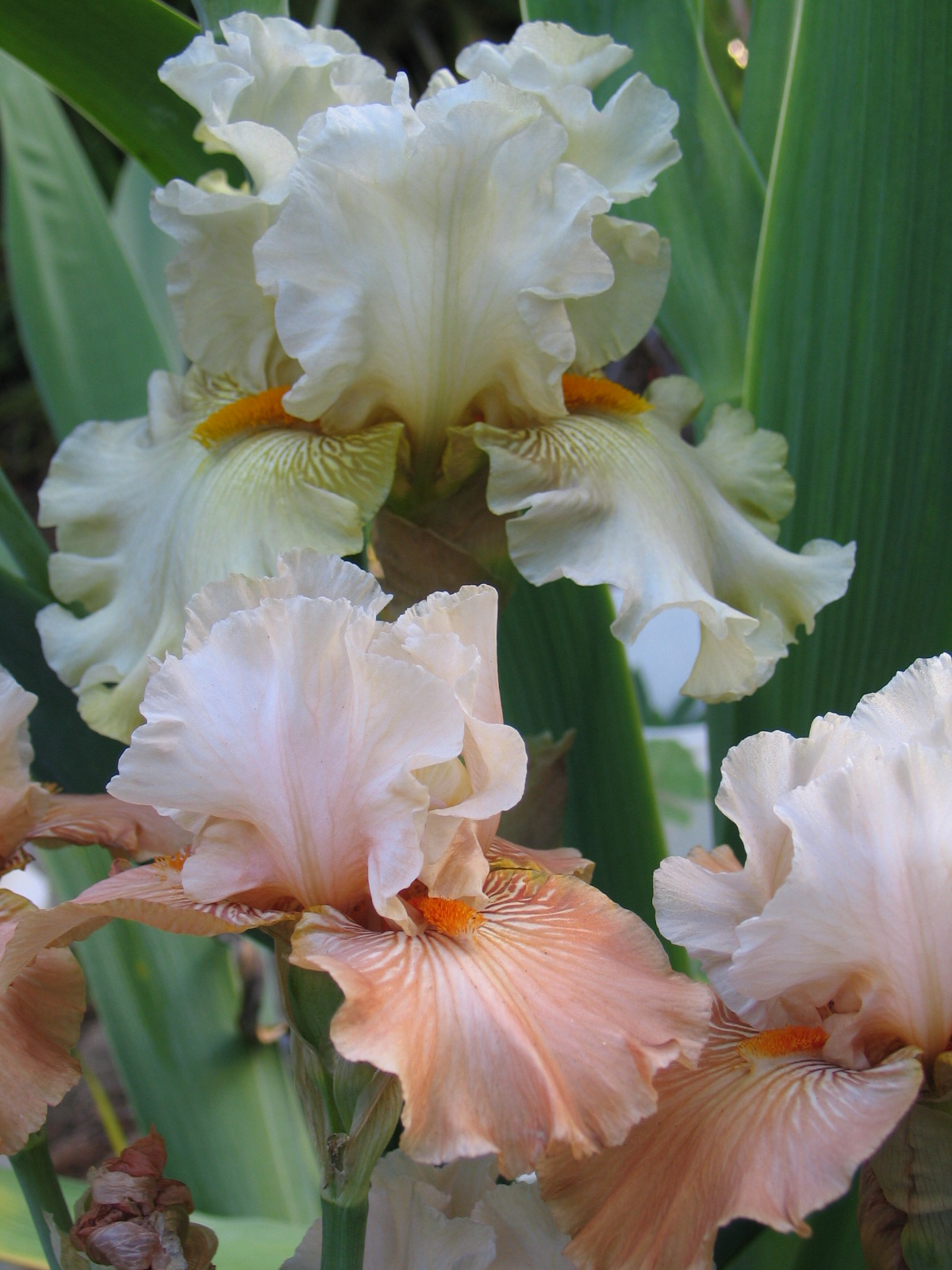
Iris 'pickledilly' mandarin morning' 3
This image has nothing to do with today's topic, but I really wanted to use it.What I do want to say today is that a successful garden design is/should be more than the sum of its parts. For this post, those parts are the client, the site, and the designer. Someday down the road, I will post again to talk about different parts (like design+installation+maintenance, or a variety of other bits).Let's consider:The Client: Their responsibility is to give the designer the information that person needs in order to generate something appropriate. They should have an idea of what they want to spend, some input on how the space will be used and by whom, and if there are any aesthetic preferences, those must be made available - preferably in the form of images and not words. If the client isn't clear about what they want from the designer, the designer may (let's hope not) assume a scope of work that is inaccurate, thus opening the door for disappointment and frustration on both ends of the relationship.The Site: The site brings a whole host of elements to the table just by being there. There may/will be existing structures, neighboring properties or views, grading and drainage issues, slopes, soil properties, existing vegetation, the angle of the sun, the quality of the light, this list could go on and on. Without the site's involvement, anything designed would probably fall into the realm of art or fantasy. The site knows what it looks like now, what it wants to look like, and what it can offer. The designer must listen to the site's input, and the client must understand that there are some things you cannot change without changing the location itself.The Designer: When a client and a site come to the purview of a designer, the designer has the responsibility to consider a whole host of issues in response, including things not discussed with the client at the initial meeting. The design solution (sounds so static, but it isn't!) must be safe, first and foremost. It must meet the criteria of the project's design program (things the client asked for - can be physical elements or intangible wishes). The solution needs to be responsive to the site's unique characteristics: the use of the site (private gardens can be very different from public parks, or weirdly similar), the budget, existing materials and spaces, and the environment among other things. The designer's goal is to find inspiration in the unique blend of the client+site, add their own technical expertise and an artistic touch, and pull off something that is both functional, safe, and appealing.The whole of the Client + Site + Designer = a design solution (we hope an installed one!) that exceeds the sum of its parts. The result is something that speaks to the client in a meaningful and maybe unexpected way, respects the site and the environment it is in, and is visually enticing. The designer would, of course, add that it should be of a quality that they would want in their portfolio, but I digress.

grading study
No, seriously, why should anyone hire a designer? I am one, but I don't do it for the money, believe me! If I didn't adore garden design, I wouldn't be doing it.
I am sure I'll come back to this again and again. First off, let me note that there's a difference between hiring someone whose job it is to design for your project and act as your advocate vs. someone who's job it is to buy (and markup) the materials, install the elements, maintain it, or do any other sales-affiliated work. This 'sales' person could be an ambitious gardener, a design-build company, or a straight-up contractor. There is overlap everywhere, as soon as I say that contractors can't design, someone will send me a link to a contracting company that hires professional designers.
If knowing that the person you hire is interested only in the safety and aesthetics of the project, and is advocating exclusively on your behalf, you should hire a designer. It is your designer's job to be cost-conscious and to listen to what you need. I have worked in firms that charged design fees based on construction cost - I always hated that. There isn't a design fee difference in designing a patio out of bluestone vs. limestone or brick. If your fence is Pine or Redwood, the details take the same amount of time to draw. However, those folks in the 'sales' business have a different profit margin based on the cost of the materials you select.
I worked for a while as a designer at a retail nursery. It was my job to design plantings for people's homes. I was expected to use the plants currently in the nursery and not ask for a special order. If the client bought their plants from the nursery, the design fee (a whopping $50.) was waived! In addition, my clients got planting plans that were specific to the time of year that they hired us in. If someone came in during summer, they got summer season plants. The good part was that I could actually pull aside the materials I was proposing and set them aside for the client to see in real life. Today, I rely on digital images, sketches, and visits to multiple nurseries instead.
So why hire a designer? The expectation is that the design work will be well-rounded, fitted to your budget, lifestyle, and aesthetics. The designer should help you make sound decisions based on form and function, not their own bottom line.